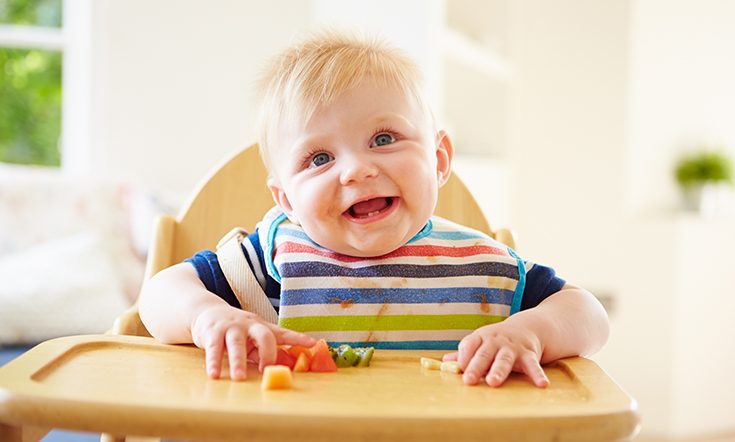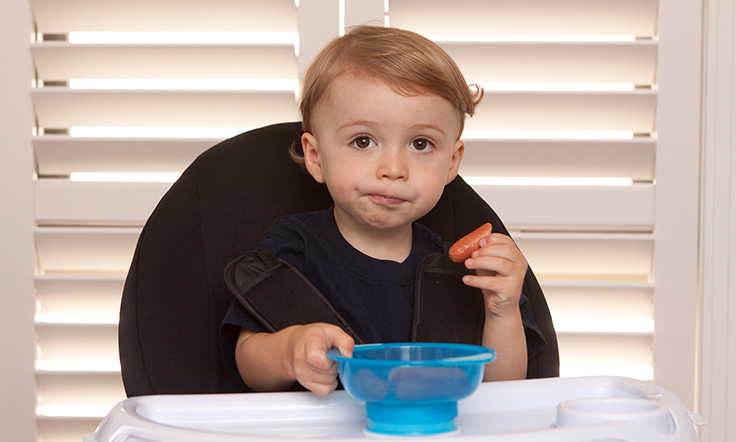

Baby-led weaning (BLW) is essentially allowing your baby to feed themselves. Rather than cooking and preparing purees that need to be fed to your baby using a spoon, baby-led weaning allows for you to provide ‘finger-food’ to your baby so they can feed themselves. Spoon feeding purees does not teach a baby eating skills such as picking up food, moving it to their mouth or how to use their tongue and jaws.
Shae Rickards, Paediatric Dietitian, says “Puréed food is an adaptation to the introduction of solids at an inappropriate age, when they are not physiologically ready. They came about when babies were not breastfed and formulas were incomplete, so they needed to be fed foods other than milk before they were developmentally ready for them.”
Shae explains that “babies who are breastfed are able to regulate the amount of milk they take from the breast. Similarly, with BLW they are then able to regulate the amount of food they put in their mouth. They continue to self-regulate and are able to respond to hunger cues. Self-feeding during breastfeeding underpins the theory of BLW and for infants who are formula-fed, this approach works equally as well.”
Allowing your baby to control their own intake of food at this early age allows for self-regulation as an adult. Research has supported the importance of self-regulation throughout childhood with the potential to lead to a healthier diet later in life.
As well as increased nutrient requirements, physical changes emerge around six months of age that enable a baby to self-feed, including the ability to sit unaided, grasp objects and bring them to their mouths, chew, and move food from the front to the back of their mouth.
It’s important to be aware that BLW is not appropriate for babies with developmental delays (such as premature babies or those with a disability), digestive problems (i.e. reflux, tongue tie, palate problems) or babies that are not showing signs of readiness) as they may not be able reach out for and chew food by six months of age, so they may not get sufficient nutrients.
Other Benefits of Baby-led Weaning:
- BLW helps babies process real food as soon as they start eating it. They’ll quickly learn how to chew through lumpy food or food with varying textures.
- It helps them hone their fine motor skills such as the pincer grip, which are the stepping stones for learning to write, getting dressed (think zips and buttons) and tying their shoe laces.
- It’s convenient. You can be out longer than anticipated and pop in to the fruit shop and buy a banana – easy snack taken care of. The same applies for preparing food at home, you don’t have to do much to prepare finger foods in advance.
- There is no pressure around meal times. The idea behind BLW is that the baby eats till they are satiated. They will only eat what they feel like.
- Because you don’t have to feed them, you can eat your meal at the same time.
Getting Started
There isn’t much you need to do to get started with BLW.
You’ll need a safe place for your baby to sit, so a high chair with a harness and a tray that can be fixed to the front will work well. Then it is a case of providing healthy appropriate finger food that your baby can help themselves to.

Start by offering a small amount of solid food once a day, then follow their cues. Increase the amount as they master the art of grasping, chewing and swallowing. It is important to be aware that there are some foods that are not appropriate for a baby under 12 months old. You can find further information on these foods here.
- Offer food in large chunks, slices or in bite sized pieces. Babies do best with a built-in handle (e.g. broccoli floret), allowing them to chew the piece that is sticking out.
- Hard vegetables and fruit will need to be steamed or boiled until soft
- Soft vegetables and fruit can be given raw
- Remove all pips and stones from fruit and vegetables
- Offer well cooked meats, remove the bones and cut the meat into strips or small thin pieces. Your baby can obtain nutrients from the meat from just sucking, they do not need to consume it entirely.
- Along with meat, fruit and vegetables, offer well cooked eggs and tofu, cooked pasta and noodles.
Precautions
It is important that your baby can sit up unassisted before you start to use BLW. If they can’t, you will need to wait as they need to be able to safely swallow their food. Never leave your baby unattended with food in front of them. Don’t be tempted to put food in your baby’s mouth – they are learning to self-feed and you may give them too much food.
Volume of Food
Many parents worry that their baby is not getting enough food through BLW. Breast milk or formula will provide the majority of nutrients required between the ages of six and 12 months. BLW will introduce a range of tastes textures to your baby, while helping them learn to chew and swallow solid food.
General Tips
It’s useful for your child to not be very hungry when you offer finger food. Simply because they may still be mastering the art of picking up food and putting in their mouths. It will make for a very frustrating and unhappy experience if they are starving but don’t have the skills to feed themselves properly.
- Expect for them not to eat too much while they are learning, this is normal. Volume will increase as they get better at feeding themselves.
- Be prepared: it will be messy and slow. But it is worth it in the long run.
- Make sure the pieces of food are big enough for them to grasp properly, but soft enough for them to chew without teeth.
- Only put out a few pieces at a time so your baby doesn’t feel overwhelmed. This is also less food for them to drop or throw!























